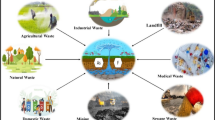Abstract
Groundwater samples were collected from shallow aquifers underneath an industrial complex in the Eastern Province of Saudi Arabia. Arsenic (As) concentrations in the groundwater samples varied between 10−8.6 and 10−6.8 M (0.18 and 11.14 µg L−1), with an average of 10−7.5 M (2.19 μ L−1). The analysis of variance for the analytical data showed that sampling locations had significantly affected As concentrations in the groundwater samples. Analytical and thermodynamic calculations showed that H2ASO4 − was the most predominant As species in acidic groundwater samples, and HAsO4 2− was the most abundant species in alkaline groundwater samples. Concentrations of H3AsO4° and AsO4 3− were too low to be important in this study. Reduced As chemical forms were also expected to be very low. All the groundwater samples were undersaturated with respect to the thermodynamic solubility isotherms of Ca3(AsO4)2(c), Fe3(AsO4)2(c), and Mn3(AsO4)2(c) minerals. Lack of reliable thermodynamic data for these arsenates could be responsible for differences between the theoretical and measured concentrations of As in the shallow groundwater samples. The general trend in the distribution of HAsO4 2− activities in the groundwater samples was parallel to that of the Ca3(AsO4)2 solubility isotherm but different from those of Fe3(AsO4)2(c), and Mn3(AsO4)2(c). These data suggest that As concentrations in the groundwater samples were probably controlled by the precipitation and dissolution of Ca3(AsO4)2 type mineral. A three step hypothesis for As interactions in groundwater/soil system is proposed that combines both solid phase formation and adsorption of As onto the solid colloidal surfaces. This hypothesis is expected to better represent As behavior in groundwater/soil environment.
Similar content being viewed by others
References
Alam, I. and Sadiq, M.: 1993, Investigation of the size of industrial wastes in the Industrial City of Jubail, Final Report, KACST Project AR-09-059.
El Khatib E.A., Bennett, O.L. and Wright, Z.: 1984a, Soil Sci. Soc. Am. J. 48, 758.
El Khatib E.A., Bennett, O.L. and Wright, Z.: 1984b, Soil Sci. Soc. Am. J. 48, 1025.
Fruchter, J. S., Rai, D. and Zachara, J.M.: 1990, Environs. Sci. Technol. 24, 1173.
Harper, T.R. and Kingham, W.: 1992, Water Environs. Res. 64, 200.
Harrison, J.B. and Berkheiser, V.E.: 1982, Clay Miner. 30, 97.
Hingston, F.J.: 1981. A Review of Anion Adsorption, in Anderson, M.A. and Rubin, A.J. (eds.), Adsorption of Inorganics at Solid-Liquid Interface, Ann Arbor Science Publication, Ann Arbor, U.S.A, p. 51.
Hsia, T.H., Lo, S.L. and Lin, C.F.: 1992, Chemosphere 25, 1825.
Jacobs, L.W., Syers, J.K. and Walker, T.W.: 1970, Soil Sci. Soc. Am. Proc. 34, 750.
Maeda, S., Ohki, A., Saikoji, S. and Naka, K.: 1992, Separation Sci. Technol. 27, 681.
Masscheleyn, P. H., Delaune, R. D. and Patrick, W. H. Jr.: 1991, Environs. Sci. Technol. 25, 1414.
NCFC: 1993, Underground water Study. Request for Quotation, National Chemical Fertilizer Co., PR# R00303, 19 May 1993.
Nightingale, H.I.: 1987, Water Resou. Bull. 23, 663.
Norrish, K.: 1975, The geochemistry and mineralogy of trace elements, in Nicholas, D.D.J. and Egan, A.R. (eds.), Trace Elements in Soil-Plant-Animal System, Academic Press, New York, p. 55.
O'Brien, P.L., Jones, D.E. and Aboteen, S.A.: 1992, Environmental impact assessment of Jubail Industrial City 1978–1988, in Environmental Impact Assessment for Developing Countries. Butterworth, p. 103.
Polemio, M., Senesi, N. and Bufo, S.A.: 1982a, Sci. Total Environs. 25, 71.
Polemio, M., Bufo, S.A. and Senesi, N.: 1982b, Plant and Soil 69, 57.
RCJY: 1988, Rasheed Geotechnical & Materials Engineers 1988. Contract No 001-T22 Environmental Control 2nd Quarter 1988 Compliance Report, The Royal Commission of Jubail and Yanbu. The Kingdom of Saudi Arabia.
Sadiq, M.: 1986, Plant and Soil 91, 241.
Sadiq, M.: 1992. Toxic Metal Chemistry in Marine Environments, Marcel Dekker Inc. New York.
Sadiq, M., Zaidi, TH. and Sheikheldin, S.: 1995, J. Environ. Health. (accepted)
Scalf, M.R., McNabb, J.F., Dunlap, W.J., Cosby, R.L. and Fryberger, J.: 1980, The United States Environmental Protection Agency Manual of Ground-water Sampling Procedures, NWWA/EPA Series. by Robert S. Kerr Environmental Research Laboratory, Oklahoma.
Walsh, L.M. and Keeney, D.R.: 1975, Behavior and phytotoxicity of inorganic arsenicals in soils, in Woolson, E.A. (ed.) Arsenical Pesticides, ACS Symp. Ser. 7, 35.
Woolson, E.A.: 1977, Hlth Perspect. 19, 73.
Author information
Authors and Affiliations
Rights and permissions
About this article
Cite this article
Sadiq, M., Alam, I. Arsenic chemistry in a groundwater aquifer from the Eastern Province of Saudi Arabia. Water Air Soil Pollut 89, 67–76 (1996). https://doi.org/10.1007/BF00300422
Received:
Accepted:
Issue Date:
DOI: https://doi.org/10.1007/BF00300422




